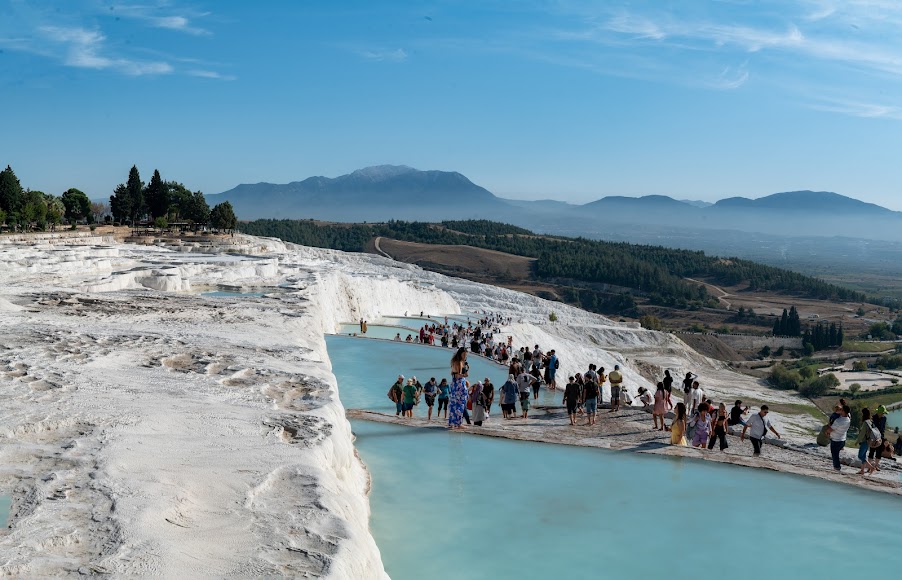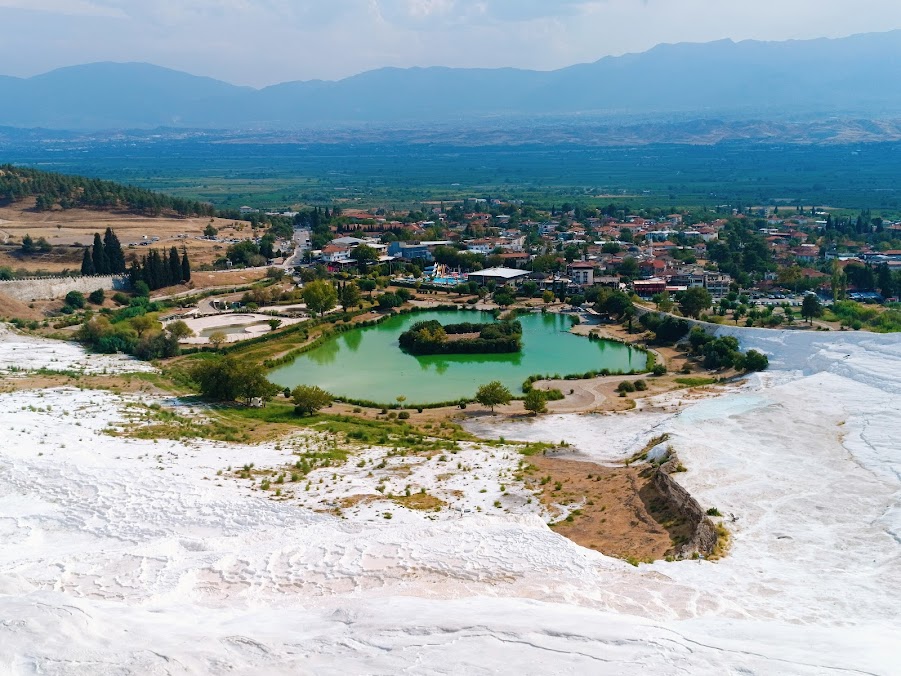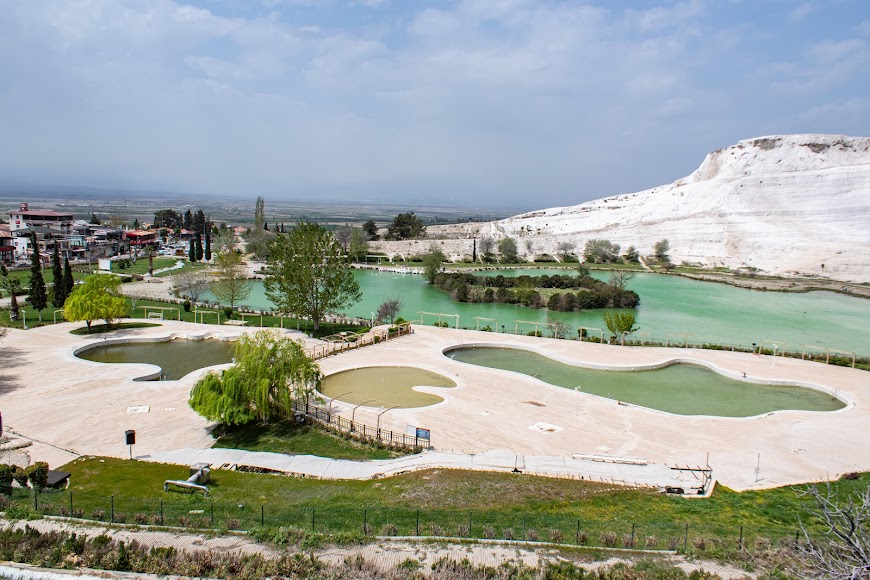When I first stepped into the mesmerizing views of Pamukkale, I was utterly enchanted by the beauty this natural paradise offers. With its unique travertines, the serenity provided by its healing springs, and the historical remnants filled with stories, this place is a heaven for travelers. In this article, I will take you on a detailed journey, starting with Pamukkale's unique natural formations, then exploring the benefits of its healing waters, and finally discussing the activities you can enjoy in this magnificent region. Let’s embark on this unparalleled beauty together!

Pamukkale's Unique Travertines
When I visited Pamukkale, the natural formation that impressed me the most was the Pamukkale Travertines. This stunning white wonder dazzles with its layer-upon-layer structure, resembling chamomile flowers. With every step, I couldn’t help but think about how these natural beauties had shaped over the years. The formation of the travertines happens as rich calcium and mineral sources mix with hot water to create such an impressive landscape on the surface.
Located at a high altitude, these travertines showcase different beauties with each season. In the summer, their white surfaces gleam under the sun, creating a cool paradise, while in the winter, they transform into a completely different fairy tale, covered in snow. Thanks to these features, each photo captures a unique atmosphere.
Swimming in the hot spring pools and walking around the travertines while enjoying the view is a wonderful experience. Moreover, the healing waters have numerous health benefits. I also wanted to spend a bit more time here to experience how this unique natural structure affected me. This place, carrying the traces of centuries in every detail, left a deep impression on me as a unique gift from nature. The beauty of the travertines is certainly a memorable holiday memory engraved in my mind.
St. Philip's Martyrdom Byzantine Gate
As you enter from the south gate, pass by the travertine blocks and the 5th-century Byzantine gate made of marble, and continue past the Doric columns of the 1st-century gymnasium. In Hierapolis, a health-focused area, this gymnasium, an important structure, was destroyed in the 7th-century earthquake. Continue forward to the foundations of the Apollo Temple. As in the temple, the eunuch priests were inclined towards the temple’s prophecies. It is said that this power concentrated in the priests who inhaled toxic fumes from the adjacent Plutonium (the underworld god Pluto). Apparently, only the priests understood the secret of holding their breath against these fumes from Hades, causing the small animals and birds they sacrificed to die immediately.
The magnificent Roman Theatre, gradually built by Emperor Hadrian and Septimius Severus, can accommodate over 12,000 spectators. The stage, mostly intact, still contains some decorative panels and VIP “box” seats at the front.
After exiting the theatre, the path leads uphill and left to the less-visited, complex octagonal structure where St. Philip is believed to have been martyred.
Frontinus Street to the Hellenistic Theatre
From the martyrdom, a rough road leading west up the slope offers magnificent views of the field and surrounding plains. Proceed towards the completely ruined Hellenistic Theatre, situated over the 2nd-century Agora, one of the largest ever discovered. This agora was surrounded by marble colonnades with Ionic columns on three sides, and the fourth side bordered by a basilica.
To reach the agora from the theatre, follow the cross path towards the poplars (alternatively, for an easier route, return to the St. Philip Martyrdom). While walking downhill in the agora, you will return to the main ridgeline path. Turning right onto the colonnaded Frontinus Street, where some original flooring and columns remain. Monumental arches once marked both ends of the city's main commercial street. The ruined Domitian Arch stands at the southern end, immediately before the large toilet building of Hierapolis.
Beyond the Domitian Arch are the ruined Roman Baths, and beyond these, an Appian Way-style paved road passes through an extraordinary necropolis stretching up to the northern gate. The tombs range from circular tumulus-style graves to elaborately decorated double-layered sarcophagi.
Pamukkale History
Pamukkale is sure to captivate you at first sight. Over 2,000 years ago, the Kingdom of Pergamon could not resist this allure and built the ancient city of Hierapolis right next to the travertines. During this time, Hierapolis served as a thermal health center, and the healing springs believed to possess therapeutic properties have attracted people from various parts of Anatolia in search of health and beauty for thousands of years. Today, people still visit the thermal pools in search of beauty and health. You, too, can enter the waters where people from the ancient world swam thousands of years ago and admire the breathtaking view of the travertines. However, these natural wonders, which have taken thousands of years to form, are quite delicate, and thus, visitors are only allowed to walk and swim in certain areas. Those who wish to stay longer and benefit from the healing waters can stay at the thermal resorts near the ancient city and the travertines, enjoying massages, thermal baths, and mud baths.
Pamukkale Entrance Fee
In 2025, the entrance fee to Pamukkale Travertines for an adult will be 1200 TL. There is no entry fee for students under 18 and teachers from the Ministry of National Education. However, it is recommended to purchase the Museum Card. This allows you to enter all museums free of charge throughout the year.

Pamukkale's Healing Waters
Every time I visit Pamukkale, I push myself to make sure I enjoy the hot spring waters before leaving. These healing waters offer an experience that relaxes both my body and soul. The natural mineral richness of the hot water has healing properties for many ailments, from skin problems to muscle aches. To experience this, taking a short swim in the pools around the travertines is quite effective.
Natural Therapy Area
In addition, there are various thermal spa facilities for people who come to discover the health benefits of these waters. Immersing yourself in these hot springs for a long time causes stress and fatigue to almost disappear. It can be thought of as a kind of natural therapy. While savoring the moments I lost myself in, I could feel all my negative thoughts flowing away with the warm waters.
An Unforgettable Experience
Besides the beauty, the surrounding environment around the healing waters is also quite pleasant. Walking around the healing waters, while watching the magnificent views offered by nature and enjoying that unique atmosphere, is an unforgettable experience every time. I highly recommend everyone planning to visit Pamukkale to experience these healing waters.

Historical Richness in Pamukkale
In addition to the natural beauties of Pamukkale, its historical wealth is also stunning. As soon as you step into this region, I can’t help but feel eager to trace the footsteps of history. The ancient city of Hierapolis is one of the most impressive places you’ll explore here. Founded in the 2nd century BC, this ancient city takes us on a journey through the depths of history with its ruins.
In Hierapolis, when you encounter the magnificent theatre, it’s impossible not to be mesmerized. Sitting in this theatre and imagining who performed on stage in the past gives a different pleasure. Also, when you get the chance to swim in the ancient pool, you can enjoy the taste of the Roman era. I should also mention that the waters of this pool have attracted both those who believed in its healing powers and those seeking entertainment.
In addition, religious structures such as St. Philip’s Church provide fascinating details for history enthusiasts. The remains of this church reflect ancient beliefs and cultural richness. Pamukkale’s historical wealth, not only with its natural beauties but also with its connections to the past, deeply impressed me. With every step, it’s possible to discover a different story, a different memory.

Activities to Do in Pamukkale
Pamukkale, along with its natural beauties, offers many various activity options. When I came here, I was curious to find out which activities I could experience the most. First of all, walking in the hot spring waters, which appear like a white blanket laid over the travertines, was a wonderful experience. The softness and warmth of the water relaxed me with every step.
Swimming is another must-do activity here. Of course, swimming in the Ancient Pool was one of the most enjoyable moments of this visit. To swim in the waters surrounded by historical ruins, while immersing yourself in both the warm water and the history, is truly an unforgettable experience. Additionally, it is also possible to enjoy a natural spa experience here by benefiting from the various healing properties of the hot springs.
However, the activities here are not limited to water activities. Nature walks around Pamukkale are also very enjoyable. The trails leading towards the foot of Pamukkale especially enchanted me. Getting lost in nature, breathing in the fresh air, and savoring the stunning views gave me perfect peace.
Lastly, tasting local flavors at the nearby restaurants is also an activity not to be missed. These dishes, which are both a feast for the eyes and for the palate, made my trip even more unforgettable. The activities Pamukkale offers turn it from just a travel destination into a true experience.


 English
English Türkçe
Türkçe